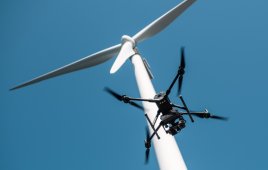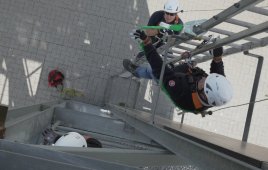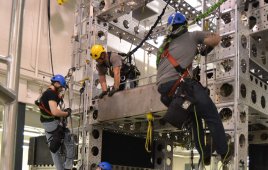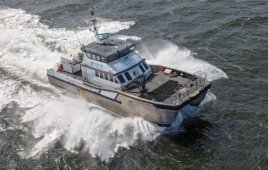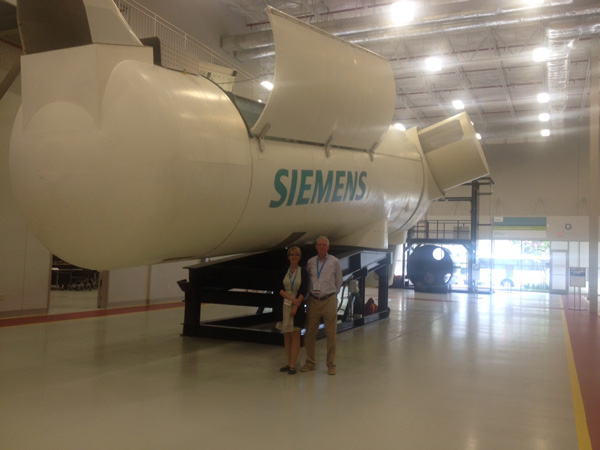
Windpower Engineering editors, Paul Dvorak and Michelle Froese, during a recent tour of Siemens’ Wind Service Training Center in Florida.
With over 25,000 MWs of wind power installed, Siemens is one of the top turbine manufacturers and service providers worldwide. They even hold the record for the world’s largest single onshore order to date: a 1,050-MW turbine order from MidAmerican Energy in Iowa.
According to the company’s website, Siemens’ platform strategy for onshore and offshore wind-power farms is to bring down the costs with innovations in blade design, generator technology, and effective use of data analysis for preventative maintenance planning. What the website doesn’t expand upon is just how much Siemens also invests in safety. Each year the company spends millions of dollars in training and education.
“Advanced technology and up-to-date equipment require skilled operators,” explained Billy Watts, during a recent press tour of their state-of-the-art Wind Service Training Center (WSTC) in Orlando, Florida. “Safety is a top priority at Siemens.”
The 40,000-square-foot center, which opened in 2013, provides highly advanced technical and safety training for installation, service technicians, and customers working at wind energy projects throughout the United States, Canada, and Latin America.
In fact, Siemens operates four training facilities worldwide, providing more than 100 different courses for educating service technicians. “Siemens offers lifelong learning and even runs regular refresher courses with training sessions open to customers and sub-contractors,” said Watts.
Although Florida might not seem like a central hub for wind energy in the U.S., the training facility is in close proximity to Siemens Power Generation Services Division’s global headquarters and it provides a central location for those traveling to the facility from South and North America.
“Given that this wind service training center will support our service activities throughout the entire North American region, Orlando’s central location offers a number of benefits including easy access for visiting trainees,” said Watts. The facility is minutes away from Orlando International Airport with 747’s regularly flying overhead, but WSTC’s soundproof walls ensure a quiet and safe training environment.
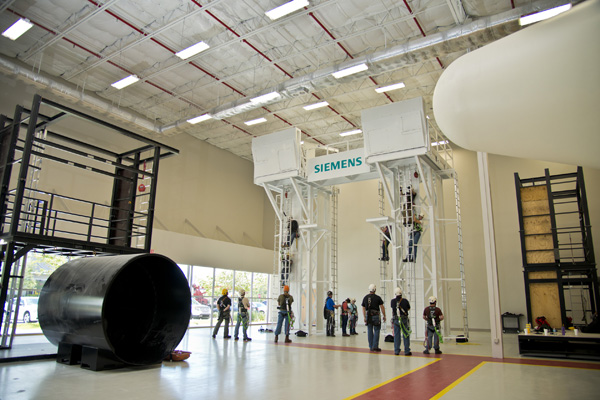
Siemens’ 40,000-square-foot training center provides advanced technical and safety training for service technicians and customers working at wind energy sites across the Americas.
Siemens other training facilities are located in Brande, Denmark; Bremen, Germany; and Newcastle in the United Kingdom. All four centers received certification from the Global Wind Energy Organization (GWO) for offering the industry’s highest level of safety training. The objective of GWO is to support an injury-free work environment in the wind industry through the development of set standards and certifications.
“Siemens is committed to operating as a zero-harm culture company, and it ensures nothing is more important than employee health and safety,” shared Watts. As an example of this commitment, students attending a class at the facility need not rent a car and gamble with unfamiliar traffic patterns. Instead, they are transported to and from their hotels by a company bus.
Together with emergency and rescue services, Siemens’ employees regularly conduct safety exercises to test and maintain their skill level. The company mandates that all trainers must have at least 100 hours of training experience and have fully completed a professional teaching qualification course.
“Technicians must repeat what they have learned over and over again under a myriad of simulated conditions to demonstrate they are equipped with the necessary skills and information to provide effective and efficient service operations,” said Watts. More than 5,000 Siemens wind turbines are installed in the Americas, creating a considerable need for the company’s wind service and training investments.
Blending classroom instruction with practical, hands-on experience, Florida’s WSTC operates as a one-stop shop for wind safety and service training. The facility offers courses that address working at heights and rescues from confined spaces, such as hubs and blades.
The facility is equipped with two full-sized Siemens nacelles, including a 2.3-MW turbine nacelle and a 3.0-MW direct-drive nacelle, each weighing over 100 tons. Three 30-ft rescue towers let technicians train and practice on the same equipment used in the field. In addition, ladder structures, electrical and hydraulic modules, and a service crane station make safety and rescue simulations similar to field conditions.
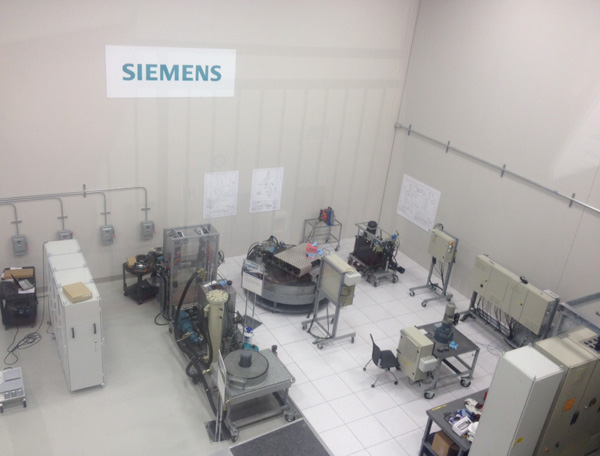
LEED Gold certified, the training center houses technology equipped training labs and spacious classrooms.
LEED Gold certified, the WSTC also houses technology equipped training labs and spacious training classrooms. To receive LEED certification, building projects must satisfy prerequisites and then earn points to achieve different levels of certification (Certified, Silver, Gold, and Platinum) based on environmentally friendly design categories.
“As more wind energy projects are developed in the U.S. and globally, Siemens is dedicated to providing the industry’s highest level of safety training and that starts with the right equipment and the right training facilities,” said Watts.
With safety a priority, Siemens is also dedicated to lowering the number of required turbine visits for their technicians. The company has invested in advanced remote monitoring and diagnostics services, so it can monitor customers’ turbines 24/7 off-site at a central location.
“Monitoring experts can solve more than 85% of all alarms remotely without a service team doing trouble-shooting onsite and up-turbine,” said Watts. Reduced turbine downtime and maintenance visits also help produce higher energy outputs at wind farms, which is a plus for the industry.
“Even with monitoring, the growth and maturation of the wind industry creates a long-term need for service and maintenance,” added Watts. “So with facilities like the WSTC here in Orlando, we make sure Siemens technicians are highly skilled so they can safely and efficiently ensure turbines operate at peak production.”
Siemens
www.siemens.com
Filed Under: Safety, Training

